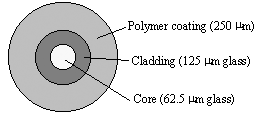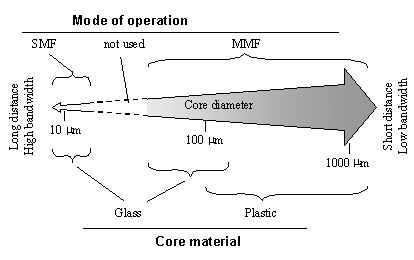Finished Core Specifications
A complete fiber- optic core is characterized by the diameter of its core, its cladding, its polymer coating, and the various mechanical and optical tolerances associated with those items (Figure 11.3). Of all the various parameters that define a fiber core, the key parameter that differentiates fiber in the marketplace is the core diameter. Fiber is segmented into different grades of electrical performance according to its core diameter.
Figure 11.3. Construction of typical coated 62.5 m m multimode fiber core.

As illustrated in Figure 11.4, large cores are classified as multimode fiber (MMF), while small cores as classified as single-mode fiber (SMF). See Section 11.5.1, "Multimode signal propagation," and Section 11.6.1, " Single-Mode Signal Propagation," for definitions of these terms. The distinction between MMF and SMF has to do with the relation between the size of the core and the wavelength of the light flowing through it.
Figure 11.4. Segmentation of the fiber marketplace according to core diameter.

The diameter of the core strongly affects both the cost and signal transmission bandwidth of a finished fiber. Enlarging the core renders a finished system less expensive but reduces the bandwidth. Larger cores reduce the overall system cost because they can accept light from less mechanically precise and less costly packages and connectors. Unfortunately, larger cores also reduce the bandwidth because they allow the light to bounce around more inside the fiber, dispersing the received optical energy over time. The smallest cores (about 10 m m diameter) deliver the greatest signal transmission bandwidth at the greatest finished system cost.
The largest cores are made from plastic, an inexpensive and easy-to-handle material. Plastic fibers have the same general optical characteristics as glass fibers; however, the optical attenuation of plastic is much higher, and the bandwidths are much lower. Plastic fibers are relegated mostly to relatively low-bandwidth, short-distance applications.
High-volume desktop LAN applications use multimode glass fiber. This fiber is produced in standard core diameters of 50, 62.5, 85, 100, and 140 m m. The most popular fibers for LAN applications are 50 and 62.5 m m.
Single-mode systems with a 10- m m core are found in long-distance telecommunications applications and LAN backbone applications where electrical performance, not cost, is the leading criteria.
For any TIA/EIA-568-B-compliant or ISO/IEC 11801-compliant core size smaller than 85 m m, the nominal cladding diameter is 125 m m and the nominal polymer coating diameter is 250 m m. This use of standard cladding and coating diameters simplifies the standardization of the connectors into which all fibers must fit.
POINT TO REMEMBER
- The key parameter that differentiates fiber in the marketplace is core diameter.
Fundamentals
- Impedance of Linear, Time-Invariant, Lumped-Element Circuits
- Power Ratios
- Rules of Scaling
- The Concept of Resonance
- Extra for Experts: Maximal Linear System Response to a Digital Input
Transmission Line Parameters
- Transmission Line Parameters
- Telegraphers Equations
- Derivation of Telegraphers Equations
- Ideal Transmission Line
- DC Resistance
- DC Conductance
- Skin Effect
- Skin-Effect Inductance
- Modeling Internal Impedance
- Concentric-Ring Skin-Effect Model
- Proximity Effect
- Surface Roughness
- Dielectric Effects
- Impedance in Series with the Return Path
- Slow-Wave Mode On-Chip
Performance Regions
- Performance Regions
- Signal Propagation Model
- Hierarchy of Regions
- Necessary Mathematics: Input Impedance and Transfer Function
- Lumped-Element Region
- RC Region
- LC Region (Constant-Loss Region)
- Skin-Effect Region
- Dielectric Loss Region
- Waveguide Dispersion Region
- Summary of Breakpoints Between Regions
- Equivalence Principle for Transmission Media
- Scaling Copper Transmission Media
- Scaling Multimode Fiber-Optic Cables
- Linear Equalization: Long Backplane Trace Example
- Adaptive Equalization: Accelerant Networks Transceiver
Frequency-Domain Modeling
- Frequency-Domain Modeling
- Going Nonlinear
- Approximations to the Fourier Transform
- Discrete Time Mapping
- Other Limitations of the FFT
- Normalizing the Output of an FFT Routine
- Useful Fourier Transform-Pairs
- Effect of Inadequate Sampling Rate
- Implementation of Frequency-Domain Simulation
- Embellishments
- Checking the Output of Your FFT Routine
Pcb (printed-circuit board) Traces
- Pcb (printed-circuit board) Traces
- Pcb Signal Propagation
- Limits to Attainable Distance
- Pcb Noise and Interference
- Pcb Connectors
- Modeling Vias
- The Future of On-Chip Interconnections
Differential Signaling
- Differential Signaling
- Single-Ended Circuits
- Two-Wire Circuits
- Differential Signaling
- Differential and Common-Mode Voltages and Currents
- Differential and Common-Mode Velocity
- Common-Mode Balance
- Common-Mode Range
- Differential to Common-Mode Conversion
- Differential Impedance
- Pcb Configurations
- Pcb Applications
- Intercabinet Applications
- LVDS Signaling
Generic Building-Cabling Standards
- Generic Building-Cabling Standards
- Generic Cabling Architecture
- SNR Budgeting
- Glossary of Cabling Terms
- Preferred Cable Combinations
- FAQ: Building-Cabling Practices
- Crossover Wiring
- Plenum-Rated Cables
- Laying Cables in an Uncooled Attic Space
- FAQ: Older Cable Types
100-Ohm Balanced Twisted-Pair Cabling
- 100-Ohm Balanced Twisted-Pair Cabling
- UTP Signal Propagation
- UTP Transmission Example: 10BASE-T
- UTP Noise and Interference
- UTP Connectors
- Issues with Screening
- Category-3 UTP at Elevated Temperature
150-Ohm STP-A Cabling
- 150-Ohm STP-A Cabling
- 150- W STP-A Signal Propagation
- 150- W STP-A Noise and Interference
- 150- W STP-A: Skew
- 150- W STP-A: Radiation and Safety
- 150- W STP-A: Comparison with UTP
- 150- W STP-A Connectors
Coaxial Cabling
- Coaxial Cabling
- Coaxial Signal Propagation
- Coaxial Cable Noise and Interference
- Coaxial Cable Connectors
Fiber-Optic Cabling
- Fiber-Optic Cabling
- Making Glass Fiber
- Finished Core Specifications
- Cabling the Fiber
- Wavelengths of Operation
- Multimode Glass Fiber-Optic Cabling
- Single-Mode Fiber-Optic Cabling
Clock Distribution
- Clock Distribution
- Extra Fries, Please
- Arithmetic of Clock Skew
- Clock Repeaters
- Stripline vs. Microstrip Delay
- Importance of Terminating Clock Lines
- Effect of Clock Receiver Thresholds
- Effect of Split Termination
- Intentional Delay Adjustments
- Driving Multiple Loads with Source Termination
- Daisy-Chain Clock Distribution
- The Jitters
- Power Supply Filtering for Clock Sources, Repeaters, and PLL Circuits
- Intentional Clock Modulation
- Reduced-Voltage Signaling
- Controlling Crosstalk on Clock Lines
- Reducing Emissions
Time-Domain Simulation Tools and Methods
- Ringing in a New Era
- Signal Integrity Simulation Process
- The Underlying Simulation Engine
- IBIS (I/O Buffer Information Specification)
- IBIS: History and Future Direction
- IBIS: Issues with Interpolation
- IBIS: Issues with SSO Noise
- Nature of EMC Work
- Power and Ground Resonance
Points to Remember
Appendix A. Building a Signal Integrity Department
Appendix B. Calculation of Loss Slope
Appendix C. Two-Port Analysis
- Appendix C. Two-Port Analysis
- Simple Cases Involving Transmission Lines
- Fully Configured Transmission Line
- Complicated Configurations
Appendix D. Accuracy of Pi Model
Appendix E. erf( )
Notes
EAN: N/A
Pages: 163
